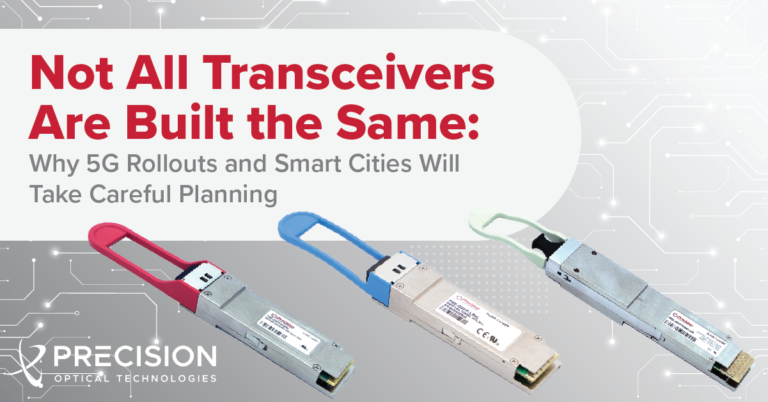
Not All Transceivers Are Built the Same: 3 Elements Network Operators Need to Verify

If you’ve been keeping up with us, you’ve likely realized that we are big believers in high quality and interoperability. From our stress-testing labs to our engineers with advanced expertise, we’re constantly pushing the message that third-party optical equipment manufacturers can compete with the legacy NEMs – and provide the systems integration expertise to ensure our network operator customers enjoy the performance and reliability they need.
That’s why we want to talk about an underlying truth of optical equipment manufacturing: not all transceivers are built the same or perform equally, even when they may be labeled as such. Let’s look at a few ways this occurs and why you must be careful when selecting your vendors.
TOSA Laser Type and Its Effect on Performance
The first area we will look at today has to do with one of the most expensive components of a transceiver – the Transmitter Optical Sub Assembly (TOSA). As a component used in optical networking, a TOSA consists of a laser diode, optical interface, monitor photodiode, and an electrical interface. It converts electrical signals into optical ones so that data can be transmitted over fiber networks. The performance of TOSA lasers plays a critical role in the overall performance of the optical network and can impact factors such as transmission distance, data rate, and signal quality.
It all has to do with the type of technology it leverages – Electro-absorption Modulated Lasers (EML) or Directly Modulated Lasers (DML). While the issue is not necessarily the technology itself, we have seen instances where certain transceivers have been listed with the same specifications, but in actuality, the TOSAs were different on account of the technology leveraged. In one specific case, an SFP28 transceiver was billed by another manufacturer as providing the same performance as the model we were providing but at a lower cost. On paper, both appeared to be built the same. However, closer inspection revealed that the other manufacturer’s TOSA was utilizing DML technology (versus ours with EML), which would translate into unexpected issues for anyone purchasing it and expecting exactly the same performance as ours.
That’s not to say that there isn’t a use case for using DML technology. If we briefly compare both technologies, though, the difference becomes clear. The EML’s use of external electro-absorption modulators enables stable wavelengths under high-speed operation, which is optimal for long-haul and metro network applications over longer transmission distances. On the other hand, the use of direct modulation in DMLs changes the laser properties, including its refractive index. This results in larger chromatic dispersion, lower frequency response, a lower extinction ratio and overall performance degradation at distances above 10 kilometers (km).
Coming back to the scenario above, if a network operator with longer link-distance needs had purchased what appeared to be exactly the same transceiver as ours but with a DML TOSA (as opposed to an EML one), they would not achieve the performance they wanted. That’s why partnering with a vendor that makes the differences explicit is crucial. To be clear, here at Precision OT, we offer transceivers with TOSAs that use both DML and EML technology. However, we make that clear to our customers so they can get exactly what they need for their particular applications (i.e., long-haul transport versus connections within a data center) – without obfuscation or sleight of hand.
Transceiver Casing, Bail Latches and Equipment Management Problems
Another area in which vendor differences can have a major impact on network operator performance has to do with the design of the transceiver’s casing. This topic is not often talked about relative to all the attention that normally goes into the components and technologies that exist within the transceiver. However, faulty external designs can result in expensive problems down the line. For example, we’ve encountered customers having difficulties with optics that have faulty latching mechanisms, causing them to get stuck in the host platforms. We have also seen bail clasp latches fail and rip right off the transceiver. Poor thermal expansion properties have also caused serious insertion and removal issues as well as electrical shorting of internal components. Given that optical transceivers often add up to a significant cost for network operators, purchasing from a vendor that uses cheap materials in the manufacturing process can create budgetary headaches down the line.
Network operators must also recognize the importance of the metal alloys used in transceiver manufacturing, especially when an optic’s power consumption nears the limit of its MSA. The most common metals used in transceiver alloys include copper, aluminum, zinc and stainless steel. Here, it is important to remember that the choice of metal alloy used in a transceiver can impact its thermal performance and power consumption. Metals with higher thermal conductivity can help dissipate heat more efficiently, reducing the risk of overheating and improving performance. The use of lower quality alloys can result in operational challenges that hamper network performance. Network operators should always verify every detail of a transceiver before purchasing it from their chosen vendor.
Digital Signal Processors, PHY chips, Chip Sets: Interoperability and Power Consumption
When it comes to digital signal processors (DSPs), PHY chips, and other chip sets, network operators need to be aware of interoperability and power consumption issues that could come with purchasing optics from suppliers with unproven, uncertain track records.
For example, as a specialized microprocessor chip designed to perform mathematical operations on digital signals, a DSP can help compensate for distortions and impairments that occur as the optical signal travels through the fiber optic network. A reputable optical equipment supplier would typically offer optical transceivers with DSPs that come from manufacturers using high-quality components. As well, they would also perform extensive testing and validation to ensure that the DSPs included within their equipment are compatible with other current-generation DSPs. On the other hand, some third-party optical equipment suppliers might try to offer transceivers with DSPs sourced from atypical manufacturers using lower-cost components in their products. It’s important not to fall into the trap of potentially spending less money up front, however.
The reason for this cautionary advice is simple. Procuring optical equipment from unbranded suppliers could result in a network operator having DSPs that do not interoperate with other existing networking equipment. And, even if they do work, these DSPs could still result in higher-than-desired operating costs due to higher power consumption than modern, high-quality DSPs. This also applies to PHY chips and other chipsets as well. As you can probably guess by now, vetting potential vendors is critical for the health of your networks (and budget).
Fortunately, there is a better way.
At Precision OT, we pay attention to the important details that ensure the transceivers and other optical networking equipment we offer is always high-quality, interoperable and reliable. We take great pride in the extensive testing we do in our labs and the systems integration expertise our engineers offer – it’s who we are as a brand! But there’s also another mechanism at play that keeps us, as a third-party provider, a trusted partner (did someone say proven track record?) for many of the biggest names in the optical networking space: the fact that we are TAA compliant. Whether it’s industry or governmental standards that we are compliant with, you can rest assured that our products will work as described and give you the peace of mind you need to take your networks into the future. Contact us today to learn more.






